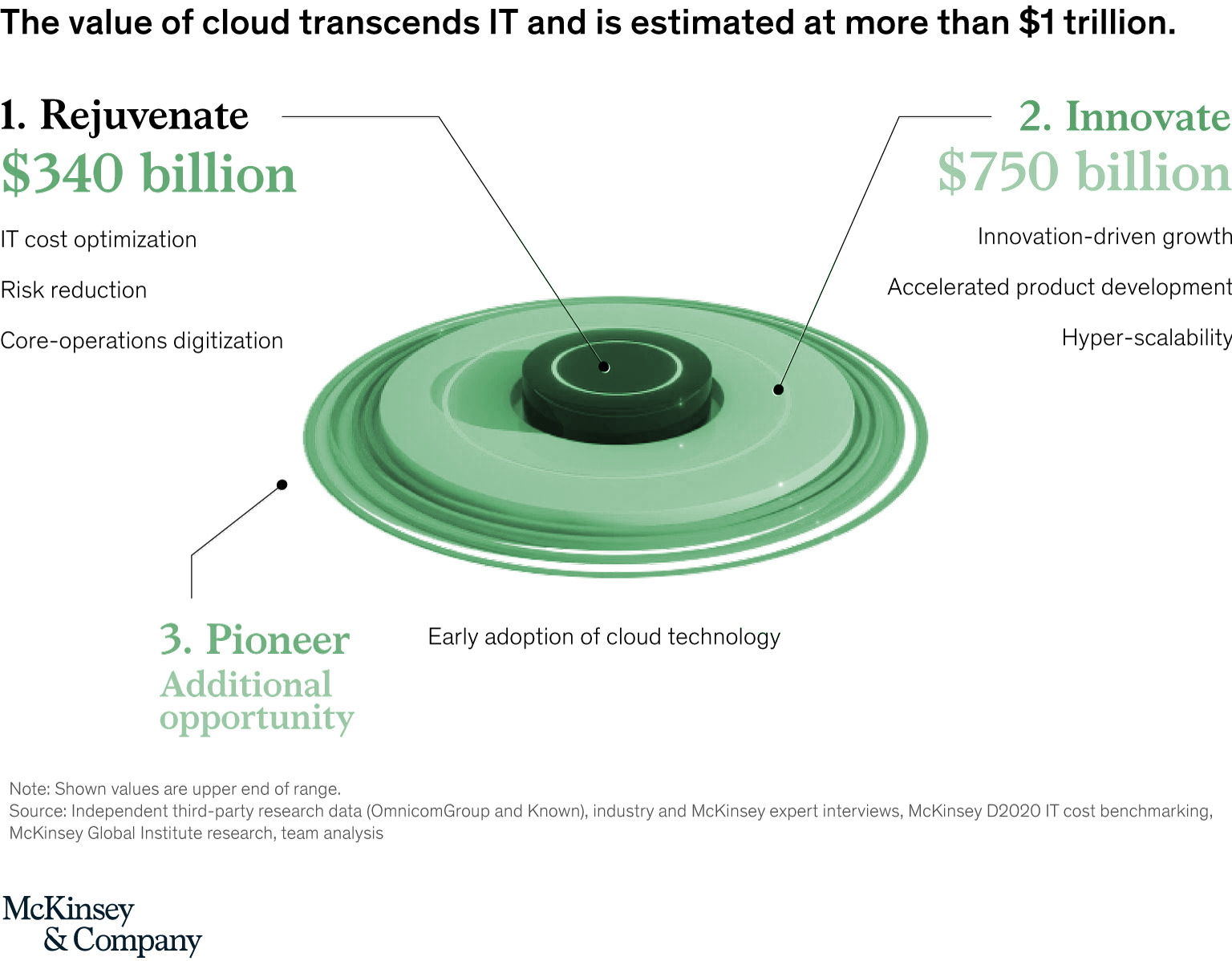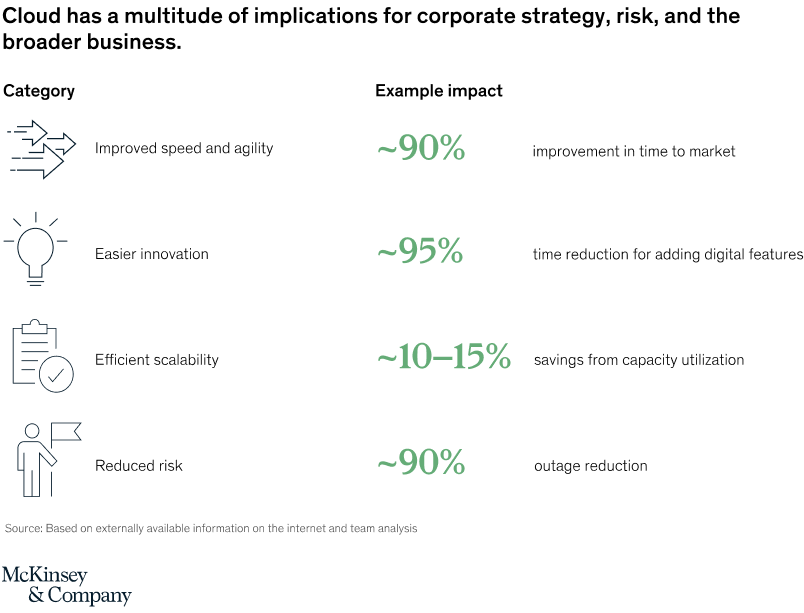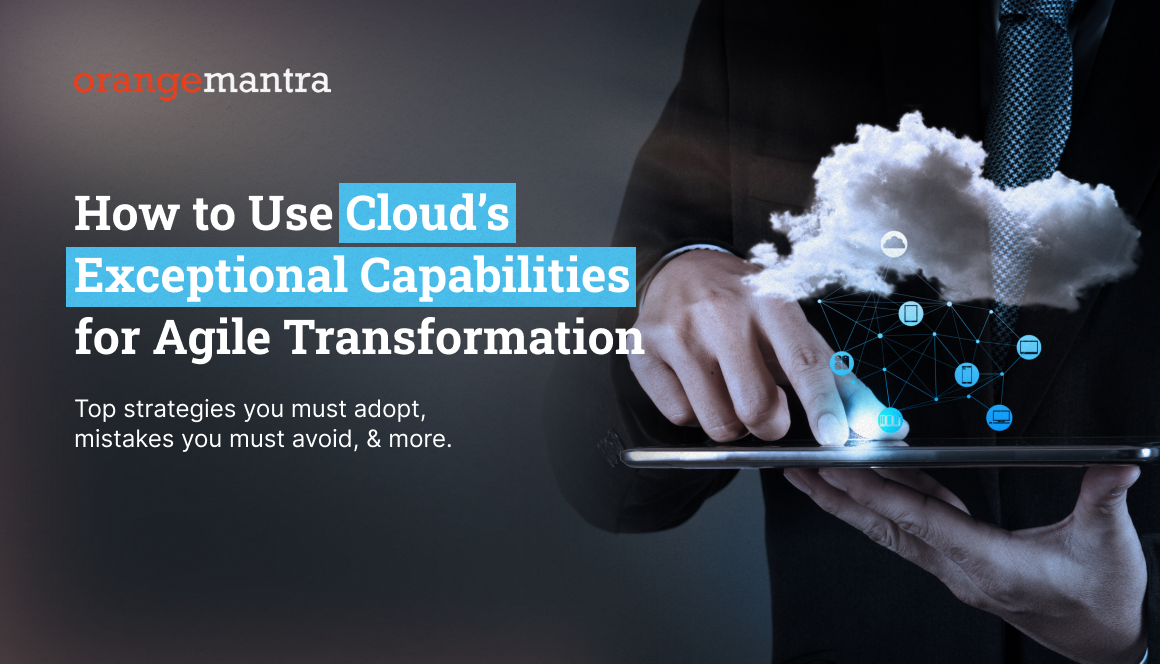With new capabilities, the cloud has the potential to help your business thrive. All you need to know is how to use it effectively. Enterprises nowadays only use the name cloud solutions rather than removing the cover to reveal the powers it possesses. Recent studies showed how different strategies can unleash the power of the cloud. Businesses are beginning to realize the value of cloud solutions, which was just the catalyst for innovation and digital transformation.
The emergence of this massive value pool comes at a time when companies are under increasing competitive pressure. Fast-moving digital players are transforming the business landscape and hastening the pace of change. Let’s look at how well-planned strategies can help your business accelerate to new heights.

Cloud’s value dimensions
Here are some values of the cloud which are evolving and can help organizations and leaders shape their tech-driven transformation.
Rejuvenate
As traditional legacy approaches are not compatible with modern technologies, cloud solution providers are there to help lower costs, risk, and IT operations. Because the on-premise model no longer efficiently works for managing applications. On the other hand, the cloud can be a complicated service yet has the power to leverage on high utilization.
Along with essaying cybersecurity breaches cloud can improve platform integrity like DevOps services through automated, embedded security processes and controls. Cloud services can rejuvenate by handling mundane tasks and reducing manual efforts.
Invent
Now the second crucial dimension entails using cloud technologies such as advanced analytics, IoT, and automation at scale to accelerate or enable innovation. Because these values allow businesses to ensure innovation-driven growth while also balancing operations. Although some organizations fail faster than they develop because they use cloud services ‘just’ for using them. When launching or expanding a business, executives who embrace cloud avoid upfront capital investments.
Pioneer
It’s the last yet evolving dimension of cloud values. Once an enterprise has reached a certain level of cloud maturity, it can extend the value of the cloud. Companies can use the cloud at this stage to experiment with new technologies such as blockchain, quantum computing, augmented and virtual reality, etc. Organizations can use emerging technologies such as digital transformation with cloud technologies for more positive outcomes. Though this approach is not yet so accepted throughout the industry vertical yet is still transforming.
Proven Strategies to Successfully Adopt an Agile Management
Here are some strategies to strengthen senior management role in enterprise transformation and growth.
Focus on the highest-value pools
Cloud has always been used to delegate IT in the infrastructure for intelligent decision-making. But it has now there to help in various business-wide verticals and possibilities. Because the management can consider how the cloud will strategize business and leverage its capabilities. Furthermore, those struggling to avail of new features can also use cloud efficiency to iterate and analyze the newly unleashed technology benefits. They can also use cloud solutions with digital transformation for balancing business operations.
Analyze financial benefits
We focus on pools by utilizing the full potential of cloud services. Now, we must also consider the financial benefits it has in store for us. Boards should ensure the management regarding the business cases, break-even points, and investments to target the genuine value. Because the cloud focuses on operating expenditures, it should have a review on how to manage finances and drive profit. Boards have a more direct impact on the finances by directing management to:
- Increase the run-rate benefits of the cloud transformation
- Accelerate migration timelines
- Reduce investments
Track risk management
If an enterprise doesn’t rely on innovative technologies, it becomes challenging for boards to track down any digital or cloud risk. While migrating to the cloud, the management is responsible for approving cloud services backed by an authentic risk-governance framework. You can also consult cloud solution company for more technical guidance. And should evaluate it with data security and risk management to avoid data risks.
Here are the four key risk areas that boards must conquer:
- Organizations with a larger IT footprint deal with a larger surface for cyberattacks through cyber governance.
- Regulatory issues can arise if the cloud is used.
- Implementing cloud transformations create dependencies with other IT transitions and business-supporting systems.
- When collaborating with cloud solutions providers, boards must assist companies in weighing the costs and benefits of every integration.
Operating on a product-led prototype
If an enterprise works on an operating model, then during migration, it should evolve around cloud advantages like storage, flexibility, and capabilities. While focusing on cost, time and projects will degrade the quality and create barriers to transition. So the ultimate focus should be on customer and employee satisfaction, DevOps services and infrastructure reliability.
And it is also necessary to communicate the deliverables, key performance indicators (KPIs), and value generated. As a result, the product-based and project-based teams must maintain their dependability. Boards must also ensure that management tracks talent development as a competitive advantage while enduring technical expertise and cloud proficiency into account.

Mistakes to avoid in cloud economics planning
Decision makers must carefully avoid some errors when planning on cloud economics.
Business plan for the financial operations
When you plan business cases, the value balances, are on the lift and shift approach. Although, cloud solution providers enable enterprises to build cloud footprints and solutions. The economic advantages stem primarily from lower hosting, storage, and maintenance costs. Unfortunately, those benefits are ignored because companies retain much technical debt and operational inefficiencies of those migrated applications. For example, financial services companies are increasing adopting cloud for transformation.
And which ultimately prevents them from taking advantage of the cloud’s dynamic infrastructure provisioning. But these benefits disappear for enterprises planning for one year. Implementing all these benefits requires an investment in a strong foundation, automation, and operation. Companies can build a business case that focuses on the genuine value of the cloud and develop a migration plan to capture it with a clear view of year one economics.
Average cost vs. incremental cost
In the traditional capital-expenditure model, the cost of consuming additional infrastructure capacity is minimal. And companies measure their cost efficiency by looking at their average cost and infrastructure utilization level. But cloud allows the limitless opportunity to the enterprise for the expenditure model and pay for usage. It depends on the enterprises to work proactively by analyzing the services that fulfill their workload requirements. It also allows firms to use an incremental expenditure approach according to their needs. You can also consult cloud solutions company for more technical guidance.
Forecasting based on historical experience
As we experience new technology every minute, we can’t forecast cloud services due to previous experiences of 5 to 10 years. As enterprises are shifting from the traditional IT capital-expenditure world to the cloud operating-expenditure world, forecasting isn’t a path to choose for cloud solutions. However, the enterprises spend a lot on the new cloud products such as DevOps services based on forecasting. And which distinguishes between forecasting and actual budget.
As a result, it leads to poor decisions and irregulated budgets. The secret to budget planning is understanding the company’s requirements and analyzing the customer’s interests. Furthermore, forecasting can be opted for analyzing unit economies to understand cloud spend and the opportunities it provides to your organization.
Automate the elasticity of cloud services
Cloud services are known for their elasticity and scalability, which help drive more sales to organizations. And this ultimately affects the workloads of the enterprises with cloud consumption patterns.
Unfortunately, companies frequently fail to distinguish workloads that benefit economically from on-demand scaling from those that do not, resulting in ever-increasing costs. While the cloud offers to abstract away from the mechanics of physical storage abilities. Along this, businesses must examine their workloads individually to determine whether their elasticity patterns would result in cloud savings.
Differentiate cloud economics and architecture
Cloud services have the potential to give optimistic cloud-utilization models. And some enterprises believe in cloud resources because of this faith. It, however, overestimates projected savings. Despite the promise of dynamically scalable cloud capacity that can be tailored to match application demand, most businesses end up with lower cloud-resource utilization than they had hoped.
High utilization rates are least partially dependent on a capable architecture because some cloud business economics and architecture are developed without involvement. And it leads to business cases centered on utilization rates that are not supported. As a result, businesses must closely align the cloud business case with the cloud-architecture transformation.
Migration of workloads to the cloud
The cloud has immense storage flexibility and scalability for enterprises, but migrating every workload to the cloud is a big NO! Cases include companies deporting massive workloads and storage services from the cloud to their custom-designed on-premises infrastructure. As the scale and flexibility can be more facilitated on-premises rather than the cloud services. So, companies with fewer workloads should be selective in cloud usage.
Conclusion
As cloud services evolve, enterprises should know to reach for the core abilities. These strategies and values will help you adopt cloud solutions in business operations. With a suitable cloud strategy in place, your company would not just have an upper hand but also achieve sustainable growth. For more consideration, consult a cloud solutions company for your projects.
FAQs
How is data protected in cloud computing?
Identity governance is the first step toward cloud data security. You require a unified view of data access across your on-premises and cloud platforms and workloads.
What are the three cloud computing layers?
- Cloud infrastructure – from servers and servers from storage.
- Content cloud – Data abstraction from applications
- Information cloud – Client access to data.
How can cloud computing help IT, professionals?
Employees can be more flexible in their work practices.























